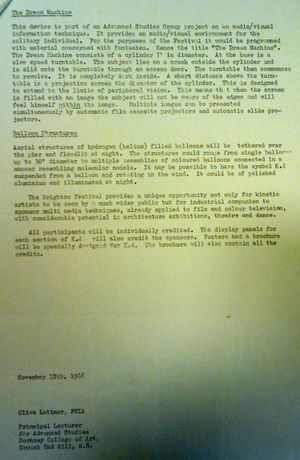DD082729
From WikiDelia
Jump to navigationJump to searchDD082729 is the second and last page of a draft programme for the Brighton Festival.
The first page is DD082706.
Transcript
The Dream Machine
-----------------
This device is part of an Advanced Studies Group project on an audio/visual
information technique. It provides an audio/visual environment fot the
solitary individual. For the purposes of the Festival it would be programmed
with material concerned with fantasies. Hence the title "The Dream Machine".
The Dream Machine consists of a cylinder 7' in diameter. At the base is a
slow speed turntable. The subject lies on a couch outside the cylinder and
is slid onto the turntabls through an access door. The turntable then commences
to revole. It is completely dark inside. A short distance above the turn-
tablr is a projection screen the diameter of the cylinder. This is designed
to extend to the limits of peripheral vision. Thie means that when the screen
is filled with an image the subject will not be aware of the edges and will
fell himself _within_ the image. Multiple images can be presented
simultaneously by automatic film cassette projectors and automatic slide pro-
jectors.
Balloon Structures
------------------
Aerial structures of hydrogen (helium) filled balloons will be tethered over
the pier and floodlit at night. The structures could range from single balloons
up to 30' diameter to multiple assemblies of coloured baloons connected in a
manner resembling molecular models. It may be possible to have the symbok K.4
suspended from a balloon and rotating in the wind. It could be of polished
aluminium and illuminated at night.
The Brighton Festival provides a unique opportunity not only for kinetic
artists to be seen by a much wider public but for industrial companies to
sponsor multi media techniques, already applied to film and colour television,
with considerable potential in architecture exhibitions, theatre and dance.
All participants will be individually credited. The display panels for
each section of K.4 will also credit the sponsors. Posters and a brochure
will be specially designed for K.4. The brochure will also contain all the
credits.
November 10th, 1966
Clive Latimer, FBIA
Principal lecturer
for Advanced Studies
Hornsey College of Art,
Crouch End Hill, N.8.
